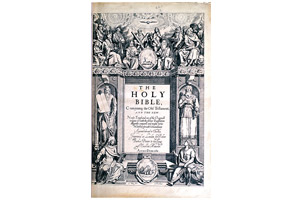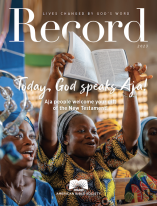The Elegant King James Bible
Celebrating 400 Years of Influence

KJV title page. (Photo courtesy of American Bible Society’s Rare Scriptures Collection)
This year commemorates the 400th anniversary of the publication of the King James Version (KJV) of the Bible. Known today for its elegance, the KJV has immeasurably shaped the rhetoric and literary expression of generations of English speakers.
James I of England convened the Hampton Court Conference of 1604 for the purpose of bringing unity among various religious factions that were dividing the English people over the text of the Bible. John Reynolds, a leading Puritan representative, suggested that a new translation of the Bible be undertaken.
Some 50 scholars from three eminent institutions — Oxford and Cambridge universities and Westminster Abbey — were divided into six groups or “companies”; three companies were assigned the Old Testament, two were assigned the New Testament, and the sixth company was assigned the apocryphal books. These scholars commenced translating late in 1604, and their goal was to produce a fresh translation in an English style that would communicate clearly to all the people the message of Scripture and unite them around a common English Bible.
With the companies diligently checking one another's drafts, the manuscript was completed in 1610, and the Bible was published in 1611. First known as the Authorized version, because its authorizing patron was King James I, it quickly became known more widely and popularly as the King James Version.
In this landmark anniversary year, American Bible Society celebrates the historic achievement of the KJV translators and the precedent they set in the ongoing field of Bible translation. This legacy continues to ensure that the message of the Bible affirms the power of God to speak to every generation through the Holy Scriptures.
A Brief History of the English Bible
American Bible Society celebrates the historic achievement of the King James Version translators, who set a precedent in the ongoing field of translation.
3rd–2nd century B.C.
Septuagint Greek Old Testament
4th century A.D.
Jerome's Latin Bible (Vulgate)
ca. 1384
Wycliffe's Bible
John
Wycliffe realized that a Bible in English was needed, and under his
inspiration the first translation of the entire Bible into English was
made from Latin.
1526-1531
Tyndale's New Testament, Old Testament Portions
When
church authorities in England prohibited a new English translation,
William Tyndale went to Germany where he translated the New Testament
from the original Greek. He also translated portions of the Old
Testament (Pentateuch, 1530; Jonah 1531). This first-printed English New
Testament was published in 1526 and smuggled into England but
frequently confiscated.
1535
Coverdale's Bible
Like
Tyndale, Miles Coverdale fled to Germany to complete a translation of
the Bible. He used Latin and German versions as well as Tyndale's New
Testament and portions of the Old Testament. This was the first printed
English Bible.
1537
Matthew's Bible
Matthew's
Bible, a revision by John Rogers of Tyndale's work, contained
additional sections of Tyndale's unpublished work and portions
translated by Coverdale.
1539
The Great Bible
Largely
a revision of Matthew's Bible undertaken by Coverdale and incorporating
good contemporary scholarship, it got its name because of the large
format used to facilitate church use.
1560
The Geneva Bible
A revision of the Great Bible, with decidedly Protestant commentary, produced by English Puritans in Geneva.
1568
The Bishops' Bible
A revision of the Great Bible, prepared by Matthew Parker and others, served as the base for the revision ordered by King James.
1611
King James Bible
For
more than 250 years, the King James Bible was supreme among
English-speaking people. During the last century, knowledge from
newly-discovered manuscripts, archaeological discoveries and recent
scholarship has led to its revision, and also to meaning-for-meaning
functional equivalent translations, an approach to translation pioneered
by Dr. Eugene A. Nida, a premier linguist and Bible translation
theoretician, who worked more than 50 years for and with American Bible
Society.
Selected Modern Translations into English
1881 – 1885
First “Revised Version” published in England
1901
American Standard Version
A modification of the English Revised Version
1913 – 1924
Moffatt Bible
1917
Jewish Publication Society Hebrew Bible
1923 – 1927
Smith-Goodspeed Bible, An American Translation
1946 – 1952
Revised Standard Version
1962 – 1982
Jewish Publication Society Tanakh
Torah (1962); Prophets (1978); Writings (1982)
1963 -1971
New American Standard Bible
1966
The Jerusalem Bible
1966-1976-1979
Good News Bible
1970
The New English Bible
1970
New American Bible
1973 – 1978
New International Version
1978-1986, 1991
International Children's Bible/New Century Version
1979 – 1982
New King James Bible
1985
The New Jerusalem Bible
1990
The Revised English Bible
1990
New Revised Standard Version
1991-1995-1999
Contemporary English Version
1994
The Inclusive New Testament
1996
New Living Translation
1999 – 2003
Holman Christian Standard Bible
2001
English Standard Version
2004 – 2007
The Inclusive Bible
Thanks to the support of our faithful financial partners, American Bible Society has been engaging people with the life-changing message of God’s Word for more than 200 years.
Help us share God's Word where needed most.
Sign up to stay in touch with how God is changing lives with his Word!








